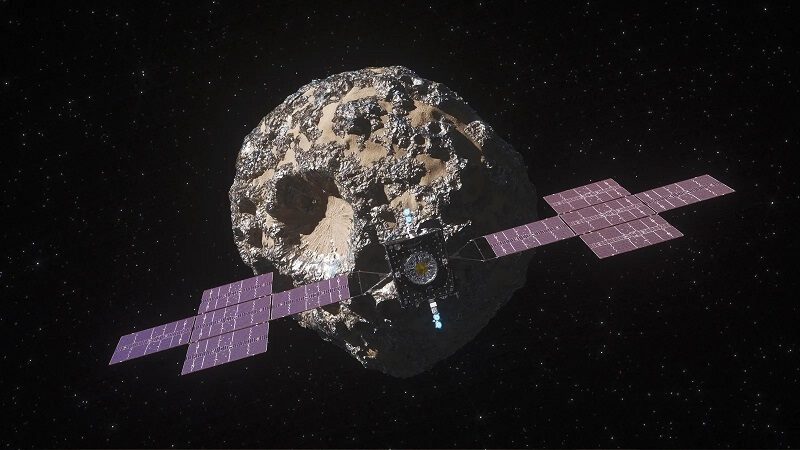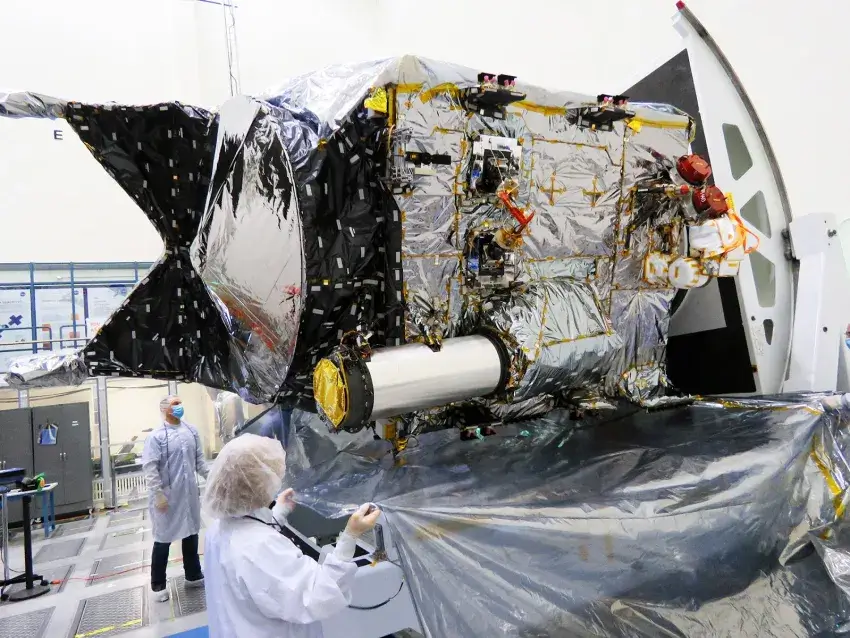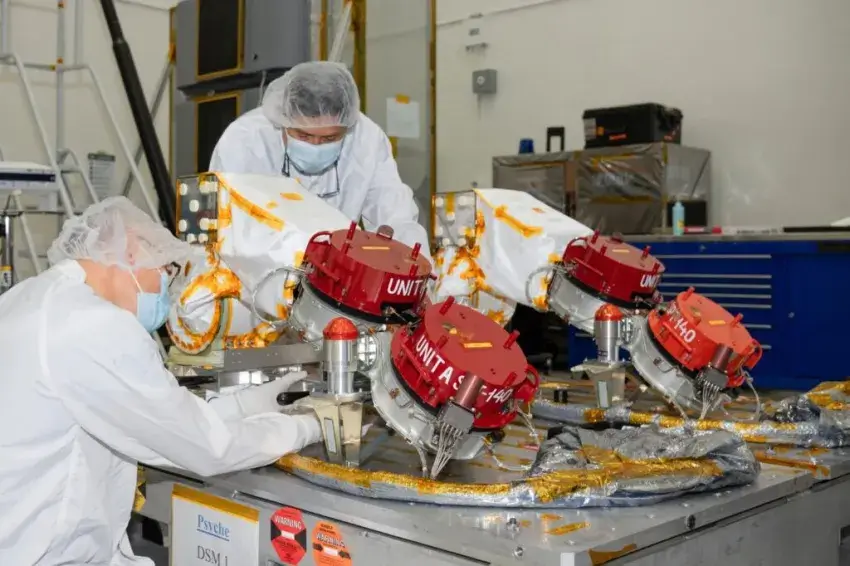
NASA Mission To A $10,000-Quadrillion Asteroid Is Two Months From Launch
"This is an opportunity to explore a new type of world — not one of rock or ice, but of metal."
By: Kristin Houser | FreeThink
NASA hopes to get a glimpse at the metal core hidden deep within Earth — by sending a spacecraft to an asteroid 280 million miles away.
Core Issue
Earth formed about 4.5 billion years ago, when the dust and gas surrounding our sun began to clump together. Initially, these materials were super-hot, but as they cooled, denser ones settled at the centre of the planet, eventually forming Earth’s core.
Scientists believe electric currents in Earth’s hot metal core are responsible for the planet’s magnetic field, which plays a key role in our planet’s habitability, keeping our atmosphere in place and deflecting the solar wind.
“If there were no magnetic field, we might have a very different atmosphere left without life as we know it,” said Eftyhia Zesta, chief of NASA’s Geospace Physics Laboratory.
NASA Gives Blue Origin $35 Million To Turn Moon Dust Into Solar Cells
“16 Psyche is the only known object of its kind in the solar system.” – Lindy Elkins-Tanton
Given that Earth is the only place in the universe where life as we know it exists, and its core is key to that habitability, learning more about Earth’s core could potentially help us figure out where to look for extraterrestrial life.
Direct observations are impossible, though — the core starts 1,800 miles below the surface, and the farthest down we’ve drilled (so far) was just 7.5 miles.
16 Psyche
With no way to directly observe Earth’s core, NASA is doing the next best thing, sending a spacecraft to study a giant metal asteroid it believes may be the partial core of a “planetesimal,” a solid object that could serve as the foundation for a planet.
This asteroid, 16 Psyche, is located about 280 million miles away, and if you could pull it down to Earth, you’d have $10,000 quadrillion worth of nickel on your hands (ignoring the fact that the sudden increase in supply would cause the metal’s value to plummet).
“We learn about inner space by visiting outer space.” – Lindy Elkins-Tanton
NASA doesn’t plan to mine 16 Psyche, though — just study it.
“This is an opportunity to explore a new type of world — not one of rock or ice, but of metal,” said Lindy Elkins-Tanton, principal investigator of the Psyche mission, in 2017, when NASA authorized the project.
“16 Psyche is the only known object of its kind in the solar system, and this is the only way humans will ever visit a core,” she continued. “We learn about inner space by visiting outer space.”
The mission is expected to start with the October 5 launch of the Psyche spacecraft. After taking an energy-saving 2.5-billion-mile path to the asteroid, the craft should arrive at its destination in 2026. It will then spend 26 months orbiting 16 Psyche from 4 different altitudes.
During this period, Psyche will use its array of instruments to image the asteroid and measure its gravity, magnetic field, and electromagnetic radiation — these measurements should help NASA determine whether it really is a planetary core.
“If Psyche still has some sort of remnant magnetic field, that probably tells us it really was a core,” said Henry Stone, Psyche’s project manager. “It’s a strong indicator.”

Bonus Features
Aside from giving scientists their first up-close look at a metal asteroid, the Psyche mission will also give NASA a chance to test out new communication and propulsion systems.
Since the 1950s, NASA has relied almost exclusively on radio signals to communicate with spacecraft, but those systems are slow — it takes anywhere from 30 minutes to several hours to send one high-resolution colour image from a Mars rover to Earth — and if we’re going to send people to Mars and beyond, we’re going to need a faster way to communicate with them.
The signal itself can’t travel any faster, but NASA has recently been experimenting with optical communications systems, which use invisible lasers to transmit information. This allows it to send up to 100 times more data in the same transmission than is possible with radio communications systems.
NASA’s only two-way demonstration of laser communications has been with a spacecraft just 22,000 miles above Earth — the moon is 240,000 miles away, for reference — so it doesn’t know how well the approach would work at vast distances, which is where faster communication would be most useful.
To find out, it’s using Psyche to demonstrate the Deep Space Optical Communications (DSOC) system. This technology will be used to communicate with the spacecraft once or twice per week until the spacecraft is near Mars, which should take about two years.

In addition to facilitating the first deep-space demo of a laser communications system, Psyche will also be the first spacecraft to use a solar electric propulsion system featuring Hall thrusters to travel through deep space (the tech has been used around Earth and the moon).
This system will use large solar arrays to generate electricity that four Hall thrusters will use to separate charged atoms from the neutral gas xenon and accelerate them out the back of the spacecraft.
This generates very little thrust, but because Psyche will be traveling in the vacuum of space, a little acceleration is all it needs to eventually reach a speed of 124,000 mph relative to Earth. This solar electric system is also highly efficient — if Psyche were relying on chemical thrusters, it would need 15 times as much propellant.
“Even in the beginning, when we were first designing the mission in 2012, we were talking about solar electric propulsion as part of the plan,” said Elkins-Tanton. “Without it, we wouldn’t have the Psyche mission. And it’s become part of the character of the mission. It takes a specialized team to calculate trajectories and orbits using solar electric propulsion.”

Looking Ahead
NASA researchers are now in the final stages of Psyche mission prep.
On August 3, they successfully tested and installed the spacecraft’s solar array, which is about the size of five parking spaces when fully deployed. Around mid-August, they plan to start fuelling it up with nearly 2,400 pounds of xenon.
If all goes according to plan, the SpaceX rocket carrying Psyche could lift off as soon as 10:38 a.m. EDT on October 5 — kicking off the spacecraft’s long journey to the (sort of) centre of the Earth.
* * *
NEXT UP!
John Lear: “We Control Alien Technology & There Are Colonies On Mars”
John Lear, a distinguished figure with a storied background, transcended his roles as a US Air Force captain and a skilled CIA pilot.
His legacy was shaped not only by his familial connection to the inventor of the Lear Jet, a notable engine, but also by his remarkable record of flying over 150 test planes and setting an impressive 18 World Speed Records.
Lear’s aviation expertise extended across a wide spectrum, as evidenced by his extensive career with 28 diverse aviation companies.
* * *
Some more on Space News: Somebody Else Is On The Moon: NASA Has Kept This A Secret For A Long Time
Liked it? Take a second to support Collective Spark.
We’d love to hear from you! If you have a comment about this article or if you have a tip for a future Collective Spark Story please let us know below in the comment section.
